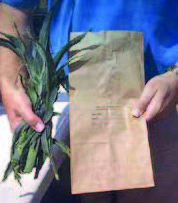By Madelyn DeJong
Product Marketing Intern
 Tissue testing is a great way to manage your nutrient levels in-season and can help boost your yields. However, it must be done correctly to see a gain in your fields this fall. As tissue testing detects whether your plant has sufficient nutrients for growth, knowing when and what to test is imperative. Keep in mind, that tissue testing should not be the only way you determine management strategies for your crops.
Tissue testing is a great way to manage your nutrient levels in-season and can help boost your yields. However, it must be done correctly to see a gain in your fields this fall. As tissue testing detects whether your plant has sufficient nutrients for growth, knowing when and what to test is imperative. Keep in mind, that tissue testing should not be the only way you determine management strategies for your crops.
According to Jerry Hartsock and Dakota Miller of Cutting Edge Consulting, “Tissue sample results are a snapshot of how the plant was feeling that day of sampling, so keep in mind the time of day you are pulling samples, the temperature during sampling, the stress the crop is under, and how much time has elapsed since the last rain. It can take a little time after a good rain for nutrition to make it into the crop and appear on a tissue test.”
Another thing to take into consideration when tissue testing is this year’s drought conditions. Certain nutrients tend to become more accumulated or deficient in the plant during a time of little rainfall. Therefore, you must be cautious when determining if there is a lack of the nutrient in the soil or if the deficiency is drought-induced.
To collect a sample, you should find 15-20 leaves that are a good representation from the field or area you are wanting to test. “The best leaf to sample is the ear leaf if it can be identified, and if it cannot yet be identified, collect the most mature leaf,” Jerry and Dakota also advise.
Keep in mind the following is a list of Do’s and Don’ts when it comes to tissue testing this growing season:
Do:
- Use Midwest Laboratories‘ free bags for sample collecting
- Leave sample bags open for 48 hours to allow the plant to dry
- Break tissue into pieces for a more compact sample
Don’t:
- Use metal containers to collect samples
- Take samples from these plants: Mechanically injured, Temperature stressed, Moisture stressed Diseased, Insect Injured or Dead
- Use dusty plants, if possible
- Take Tissue Samples during the hottest part of the day
If you have any questions on tissue testing, contact your AgVenture Yield Specialist for additional direction.